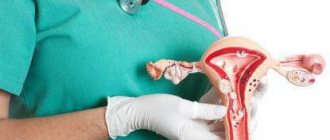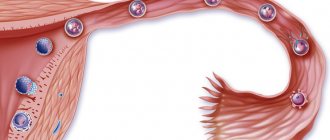Myometrium: what is it, causes of pathology
The muscular layer of the uterus normally has a small thickness, and it varies depending on the days of the cycle, sometimes growing, sometimes decreasing to its previous size.
For example, at the beginning of the cycle the thickness averages 5 mm. Hormonal changes contribute to the growth of the endometrium almost three times its original size (from 10 to 16 mm). Normally, the uterine myometrium decreases to its previous size in the second half of the cycle, after which it partially exfoliates during menstruation. One of the most common pathologies is diffuse changes, or so-called. endometriosis. The disease is manifested by increased proliferation of endometrial tissue. Doctors see hormonal reasons for this, since all women with this pathology had an imbalance - an increase in the amount of estrogen and a deficiency of progesterone. As a result of hormonal imbalance, the endometrium grows, after which it is rejected, accompanied by bleeding.
Endometrioid cells penetrate the endometrial tissue, which can cause significant thickening of the walls of the uterus. In women of reproductive age, this figure can reach 4-5 cm; during menopause, this figure becomes smaller.
At the initial stage, the disease is asymptomatic, so women do not consult a doctor.
Pathological changes contribute to the fact that the myometrial tissue becomes similar to cells, where cysts filled with hemorrhagic contents appear. The glandular tissues of the uterus also suffer. The peculiarity of the pathology is that the muscular layer of the uterus is affected unevenly, i.e. diffuse changes affect individual places, spreading heterogeneously across depth and surface.
Myometrium is heterogeneous on ultrasound: reasons for which diseases this is typical
Ultrasound diagnostics of the female reproductive system is the most optimal visualization method. It is almost always prescribed after the patient consults a gynecologist and makes it possible to detect a significant part of inflammatory, degenerative and oncological pathologies.
In this article we will look at heterogeneous myometrium, what it means and what diseases it is typical for.
What is myometrium and what should it be like normally?
The uterus is an unpaired organ of the female reproductive system, which is located in the pelvic cavity. Its main function is to carry the fetus during pregnancy. During this period, it increases significantly, but after childbirth it decreases again to its original size.
The wall of the uterus consists of three layers:
- endometrium - mucous membrane, the development of which is regulated by estrogens and progesterone;
- myometrium - three layers of smooth muscle fibers and connective tissue;
- perimeter - a serous membrane that covers the outside of an organ.
The myometrium is one of the most developed muscle tissues in the body. It consists of two layers of longitudinal fibers, between which there is one circular one. Between them there is a significant number of elastic and collagen fibers, which allows you to create elasticity without loss of strength.
During pregnancy, the muscle wall expands significantly as the baby grows and amniotic fluid accumulates. It not only maintains the shape of the organ, but also protects the fetus from external injury. The myometrium also plays a key role during childbirth, when, under the influence of prostaglandin, it begins to periodically contract, which provokes the birth of the baby towards the vagina.
Causes of heterogeneous myometrial structure
In gynecology, it is customary to identify several main reasons for the development of a heterogeneous echostructure of the myometrium:
- Development of a scar at the site of a previous cesarean section. In this place, connective tissue grows, which is a hypoechoic formation against the background of normal smooth muscle fibers.
- Uterine fibroids are the most common benign neoplasm in women. It can develop in any part of the myometrium; it is a chaotic proliferation of muscle fibers, which gradually increases. May be accompanied by pain, bleeding during pregnancy and contribute to the development of infertility. The tumor sizes range from 1-2 mm to 8-10 cm in diameter.
- Leiomyosarcoma of the uterus . Malignant neoplasm of the muscular wall of an organ with rapid development, spread to adjacent anatomical structures and distant metastases. It is observed more often in patients over 45 years of age. Accompanied by bleeding regardless of the time of menstruation, anemia, weight loss and pain in the lower abdomen. During an ultrasound examination, it appears as a cellular structure of the myometrium in the uterine wall.
- Interstitial fibroma of the uterus is a fibrous neoplasm of the uterine wall that develops from connective tissue. Characterized by the presence of a clear boundary and slow growth. The tissue structure remains homogeneous.
- Metroendometritis is a bacterial inflammation of the mucous and muscular lining of the uterus. Often occurs after medical interventions. The process can be either limited or involve almost the entire organ. It is accompanied by an infiltration process, which affects the echogenicity of the area. Sometimes purulent masses accumulate between the fibers, and small abscesses may form.
- Deposition of calcifications . Characterized by heterogeneous myometrium with hyperechoic inclusions, which are located between various muscle fibers. They are a consequence of past inflammatory processes, a sign of metabolic pathologies.
- Tuberculous metroendometritis is a fairly rare specific bacterial inflammation of the uterus. Most often occurs with disseminated tuberculosis, which is possible with reduced immune reactivity of the body. In this case, massive damage to the muscle tissue of the uterus occurs with its destruction and accumulation of inflammatory exudate. May spread to adjacent anatomical structures.
- Adenomyosis is a disease in which epithelium grows into the muscle layer. Most common during menopause.
Stages of endometriosis
Since the muscular layer of the uterus is affected heterogeneously, it is quite difficult to classify the stage of the disease. This can be done after a thorough hardware examination, which will show the condition of the myometrium. The classification is based on the depth of germination of endometrioid tissue. There are three stages of pathology:
- The internal layers are slightly affected; the pathological process affects only the submucosal layer of the uterus.
- Endometriotic tissue affects the muscle layer.
- Germination affected the perimetrium (the serous membrane of the uterus).
There is also a fourth stage of the pathology, when not only the uterus is affected, but also neighboring organs, the parietal peritoneum of the pelvis.
Restoring uniformity
Treatment for deviations in the structure of the muscle layer is prescribed on an individual basis, depending on the cause of the heterogeneity of the middle muscular uterine layer and the severity of the clinical case. Drug therapy. But in the presence of fibroids, surgery is often required to remove the benign formation. The muscle layer of the uterus will recover immediately after appropriate therapy is carried out.
In order not to encounter such a phenomenon as heterogeneous myometrium, it is necessary to undergo a preventive examination with a gynecologist and have an ultrasound scan twice a year. If any alarming symptoms appear, be it bleeding or periods that are more painful than usual, you should immediately seek help from a doctor. Prevention includes timely treatment of sexually transmitted diseases and control of hormone levels in women over the age of 40 years.
Symptoms of diffuse changes in the myometrium
During the first and second stages of the spread of the disease, women do not notice signs of pathology. At the same time, the thickness of the uterine walls is slightly increased within the acceptable norm, so it is not always possible to diagnose endometriosis. As a result, the tissue structure slowly changes, and the development of the pathological process progresses. Under favorable circumstances, some women never show signs of endometriosis or hypertension at all.
When unfavorable conditions arise, the course of the disease worsens sharply. Women begin to feel unpleasant symptoms. The growth of the endometrium can be provoked by:
- uterine injuries;
- difficult childbirth;
- abortion;
- diagnostic curettage.
As a result of disruption of the tissue structure, the symptoms of the disease manifest themselves more clearly, hypertonicity occurs, which forces women to go to the clinic for medical help.
Among the signs of pathology are:
- spontaneous uterine bleeding;
- pain in the lower abdomen;
- increased duration of menstruation;
- iron deficiency anemia;
- weakness, apathy;
- pain during sexual intercourse;
- drowsiness, lethargy;
- headaches, possible fainting.
Diagnostics
Diagnosing the pathology in a timely manner is extremely important, since treatment of endometriosis is most successful at an early stage, until the outer lining of the uterus is affected. Pathology can be determined in several ways:
- bimanual gynecological examination, during which it is possible to identify compactions in the posterior wall, retrocervical area:
- colposcopy or cervicoscopy - examination of the walls of the vagina and uterus with a special device with an image displayed on the screen, which allows you to visualize the lesions;
- hysterography - examination of an organ using a contrast agent, which makes it possible to diagnose myometrial pathologies;
- blood test - the study shows a characteristic change in diagnostic markers accompanying endometrial pathology;
- echography - carried out in the second phase of the cycle, mainly the basal layer of the endometrium is assessed (the presence of anechoic areas, rounded inclusions, uneven thickness, jaggedness of the basal layer, thickening of the uterine walls);
- spiral computed tomography - shows the heterogeneity of the layer, the presence of foci of various shapes and densities, the anterior and posterior walls have different sizes;
- Magnetic resonance imaging - confirms the results of previous studies, allows you to accurately identify even small cystic formations.
Treatment
To treat endometriosis, hormonal therapy or exposure to tissue by cauterization is used. The objectives of pathology treatment are as follows:
- remove a heterogeneous area of tissue, thereby stopping the pathological process;
- reduce the intensity of pain;
- cure infertility (if such a diagnosis already exists);
- prevent possible relapse of the disease.
Hormonal therapy is the basis of a conservative treatment method, since it is with normal hormone concentrations that the pathological process in the muscle layer can be inhibited and the endometrium can be restored. Hormones are effective at the initial stage of the disease. The treatment regimen is selected for each patient individually. The stage of pathology, age, amount of tissue growth, and the presence of other diseases are taken into account.
Taking the right medications can improve the functioning of the endocrine system.
The cyclic processes in the uterus are artificially interrupted, the level of estrogen decreases, and the activity of the reproductive system returns to normal. The following groups of drugs are used:
- oral contraceptives - are able to control tissue growth, normalize the menstrual cycle and reduce the volume of discharge;
- gonadotropin-releasing hormone antagonists - block the production of hormones and stimulate the activity of the ovaries, significantly reduce the concentration of estrogen;
- progestins - inhibit tissue growth, reduce the thickness of the lining layer.
For patients at high risk of developing diffuse changes in the muscular layer of the uterus, doctors offer prevention using the hormonal Mirena intrauterine device. It contains a container with levonorgestrel, which is released into the uterus in doses every day and inhibits the development of proliferative processes. Every five years the spiral must be changed. As a result:
- pain in the lower abdomen before and during menstruation is reduced,
- the woman's well-being improves,
- ovulation is normalized.
Surgical treatment is performed in advanced cases when conservative therapy is ineffective.
Indications for surgery are:
- lack of effect from hormonal treatment for six months;
- contraindications to the use of hormones, drug intolerance;
- metrography showed foci of pathological tissue more than two centimeters in diameter;
- damage to the ovaries by cysts;
- adhesions that cause infertility;
- severe form of the disease with damage to nearby organs and disruption of their functioning;
- a disease complicated by adenomyosis and uterine fibroids.
Prevention
Since diffuse changes in the muscular layer of the uterus are one of the most pressing problems in gynecology, the issue of preventing pathology first of all becomes important. As a result of studying the causes of the disease, doctors determined that prevention should consist of the following:
- regular examination by a doctor;
- maintaining hormonal balance;
- limiting exposure to UV rays;
- proper nutrition;
- elimination of stressful situations;
- maintaining normal weight;
- good sleep;
- rejection of bad habits;
- suitable contraception as a way to avoid abortion.
Many women do not even suspect what it is - a pathology of the muscular layer of the uterus until they encounter a problem. Infertility, long and painful menstruation, adhesions and cysts - this is an incomplete list of what pathologically altered myometrium can result in. Therefore, to prevent such complications, it is important to diagnose the disease in a timely manner and carry out complete treatment of the pathology.
Myometrium
Content:
The myometrium is the muscular (middle) lining of the uterine wall. In a normal state, the myometrial muscles are in a calm, relaxed state, but as a result of the influence of various factors, their tension may increase, i.e. the occurrence of uterine hypertonicity.
In some cases, contraction of the myometrium is necessary (for example, during childbirth or during menstruation), but in other cases, this condition may be a sign of poor women's health.
Hypertonicity of the uterus can lead to uterine bleeding when the hormonal balance changes, including during menopause, and can also cause miscarriage or premature birth of a child.
information The activity of the myometrium is most influenced by the content of hormones in a woman’s body, in particular estrogen and oxytocin.
Myometrial structure
The myometrium has a rather complex structure, consisting of three layers of smooth muscle fibers:
- Subserosal (longitudinal) layer - includes circular and longitudinal muscle fibers. Closely intertwined with the serous covering of the uterus (perimetry).
- Circular middle (vascular) layer - consists of pipe rings and corners, includes many vessels. This layer has the greatest density in the cervix.
- The submucosal (inner longitudinal) layer is built from longitudinal fibers and differs from other layers in its fragility.
additionally, due to the presence of various layers of the myometrium, the uterus acquires the ability to contract, which is necessary for the release of menstrual blood during menstruation.
Heterogeneous myometrium
In some cases, during the examination, the doctor may diagnose heterogeneous myometrium . This condition can occur when exposed to the following factors:
- induced abortions;
- a large number of pregnancies;
- hormonal imbalance in a woman’s body;
- diagnostic curettage and other intrauterine interventions;
- C-section;
- damage to the inner lining of the uterus during childbirth;
- the influence of a neurogenic factor – primarily stress.
The main signs of the appearance of myometrial heterogeneity are painful menstruation, the appearance of nagging pain in the lower abdomen, pain during the onset of ovulation, and bleeding during the intermenstrual period.
important Heterogeneous myometrium can cause female infertility.
Myometrium during pregnancy
The appearance of myometrial hypertonicity during pregnancy is one of the important reasons requiring immediate consultation with a doctor.
Despite the fact that increased uterine tone does not always lead to miscarriage or premature birth, this condition is accompanied by compression of the vessels supplying the fetus with nutrients and oxygen, which negatively affects its development.
Myometrial hypertonicity during pregnancy can occur as a result of exposure to the following factors:
- a decrease in progesterone levels during the first 10 weeks of pregnancy (during the period when the placenta is not yet fully mature for independent functioning);
- increased levels of androgens (male sex hormones);
- inflammatory diseases of the female genital organs;
- stress and strong feelings;
- infantility (underdevelopment) of the uterus.
To prevent the occurrence of myometrial hypertonicity during pregnancy, it is recommended:
- determining the level of hormones in the body at the stage of pregnancy planning;
- timely detection and treatment of inflammatory processes in the female genital area;
- refusal of artificial termination of pregnancy;
- reducing stress and anxiety by teaching relaxation techniques and avoiding conflicts.
Conclusion
dangerous If any signs of increased uterine tone appear, the expectant mother should stop doing any work, call an ambulance or a doctor and remain in a horizontal position until the doctors arrive.
In a medical facility, the pregnant woman will receive the necessary assistance, which will help reduce the risk of miscarriage or premature birth.
The main factor contributing to the normal course of pregnancy is maintaining a healthy lifestyle. Thanks to proper nutrition, giving up bad habits and ensuring sufficient physical activity, the hormonal balance in the female body is normalized and the likelihood of having a healthy baby increases.
What is myometrium and what should it be like?
The myometrium is the middle muscular layer of the uterine wall. It is formed by bundles of smooth muscle cells (myocytes) with layers of connective tissue. In the myometrium, three vaguely demarcated layers are distinguished, differing mainly in the location of the main number of cells:
- Submucosal layer underlying the basal part of the endometrium. Formed by oblique longitudinal thin muscle bundles.
- Vascular (middle) layer with a circular or circular arrangement of myocytes. It is the thickest and most powerful. This layer is richly vascularized and contains a significant number of medium and small vessels.
- The supravascular or subserous layer borders the outer serous membrane of the uterus and is formed by longitudinal and partially circular muscle bundles.
Normally, in a woman of reproductive age outside of pregnancy, the myometrium on ultrasound has a fairly homogeneous echostructure without obvious differentiation of layers, visible connective tissue layers and clearly visualized vessels. Its thickness is slightly different in the area of the fundus, middle part and isthmus, which is not a pathology and ensures the functional usefulness of uterine contractions during labor.
The echogenicity of the myometrium of the non-pregnant uterus approaches the density of the main parenchymal organs: kidneys (their cortex), liver, pancreas. During pregnancy, the muscle layer thickens significantly due to hypertrophy of myocytes and their hyperplasia (increase in the number of cells). In postmenopause, the opposite condition is observed with atrophy of all layers of the uterus, including the myometrium.
What is uterine myometrium, its structure and norms
The myometrium is one of the muscular layers of the uterus, which is located in the middle of the uterine cavity. The inside side is covered with endometrium. The main role of the myometrium is rhythmic contractions, due to which the baby is pushed out through the birth canal. The normal state for the myometrium is rest, but under the influence of some moments the muscle layer can begin to contract and become hypertonic.
The myometrium consists of three layers:
- Longitudinal layer consisting of longitudinal and circular muscle fibers. This layer is strongly connected to the serous covering of the uterus;
- The circular layer, which includes the vessels and tubular rings, is the strongest of all the layers. The highest density of this layer falls on the cervix. Due to the fact that this layer contains many small vessels, it is also sometimes called vascular;
- Submucosal layer consisting only of longitudinal fibers. The structure of this layer is very fragile and thin.
The norm for a healthy myometrium is homogeneity. Due to a number of reasons, its structure may be damaged, and then the myometrium no longer has such a uniform structure. The most basic diagnostic method, which allows you to immediately identify various pathologies in the uterine area, is ultrasound. Hysteroscopy is also a good way to get a complete picture of the appearance of the uterine myometrium.
Myometrial heterogeneity
Myometrial heterogeneity is an exclusively echographic term. That is, such a condition can be detected in a woman during her lifetime and without removing the organ (uterus) only with the help of an ultrasound scan performed using a vaginal or transabdominal sensor. Moreover, it is not always possible to determine unambiguous clinical signs corresponding to a certain type of a given pathology.
The appearance in the myometrium of hyperechoic and hypoechoic inclusions of various sizes, origins and shapes, uneven thickenings, changes in the ratio of stromal (connective tissue) cells and myocytes - all this is a deviation from the norm. In such cases, the ultrasound report indicates that the structure of the myometrium is heterogeneous. And this is the basis for obtaining a consultation with a gynecologist, since only a doctor can evaluate the results of the study and determine the need for treatment.
The fact is that sometimes the heterogeneity of the muscular layer of the uterus detected on ultrasound is not considered as a condition in need of correction. This is possible in the following cases:
- Age-related changes in the female reproductive system in the postmenopausal period, caused by a natural progressive decrease in the level of sex hormones and activity. At the same time, the entire myometrium is diffusely heterogeneous due to uneven fibrosis - atrophy with the replacement of myocytes by connective tissue.
- Consequences of damage to the uterine wall. The reason for this may be difficult childbirth, surgical interventions (including delivery by cesarean section), medical abortions with curettage, or insufficiently careful invasive examinations of the endometrium.
- Degenerative changes in the myometrium against the background of long-term, uncorrectable endocrine disorders.
But most often, heterogeneity detected on ultrasound is a pathological sign and becomes the basis for diagnosing a number of diseases.
Causes of the pathological condition
Heterogeneous myometrium has both a physiological nature and is a sign of the development of pathological conditions of the uterus. Changes in a woman’s body with age lead to physiological heterogeneity in the structure of the uterine layer. There are no symptoms indicating illness. This condition of the uterus is detected only by ultrasound. Reasons for structural change:
- difficult birth with complications;
- the impact of frequent stressful situations;
- operations in the uterine cavity, during which the middle muscular layer of the uterus was damaged;
- genetic predisposition;
- performing a caesarean section;
- thyroid dysfunction.
Depending on the reasons that led to the structural change in the myometrium, an ultrasound examination reveals deviations from the norm in such indicators as tone and echogenicity, the thickness of the uterine layers, and the size of the organ.
Why does this happen?
The main causes of heterogeneous myometrium:
- Endometriosis and its internal genital type, also called uterine adenomyosis.
- Myometritis. In the vast majority of cases, it is a consequence of complicated endometritis, so in fact we are talking about endomyometritis.
- Uterine fibroids. It can lead to local nodular changes or almost total thickening of the myometrium (in the diffuse form of the disease).
Each of these diseases not only has special symptoms, but also leads to characteristic changes in the myometrium. They can be differentiated using ultrasound; in the protocol of the study, the specialist describes the echographic picture of the detected pathology and indicates its type.
Adenomyosis is the most common cause of myometrial changes
Endometriosis is the pathological growth of endometrial cells outside the lining of the uterus. When the myometrium is predominantly affected, we speak of adenomyosis, which can be of diffuse and nodular type, and of varying degrees of severity.
This disease is classified as benign hyperplasia of a hormonal-dependent nature. So it is typical for women of reproductive age, and in the postmenopausal period and against the background of adequately selected hormonal therapy, the activity of the process subsides.
With adenomyosis, growths of endometrioid tissue appear in the myometrium. They can be of two types:
- In the form of blind branched deepening pockets communicating with the endometrial layer of the uterus. In such cases, the ultrasound report usually indicates that the echostructure of the myometrium is heterogeneous and cellular. In severe degrees of the disease, germination of the entire thickness of the myometrium is noted, which is accompanied by the formation of fistula-like formations between the uterine cavity and other structures of the small pelvis.
- In the form of nodes - closed round lesions with an uneven central cavity filled with blood or a chocolate-colored liquid mass. They are usually multiple, of varying sizes, with an uneven distribution in the uterine wall. With this variant of the disease, the conclusion of an echographic examination usually notes that the myometrium is heterogeneous with signs of adenomyosis.
Normal size of the uterus in women: table based on ultrasound during pregnancy and after childbirth
For women's health, you need to take care of your body. This especially applies to the uterus. This organ is responsible for bearing a child, and if abnormalities, infections or pathologies occur, it is necessary to undergo timely treatment.
A woman needs to know about her body, and what sizes of the uterus are normal, and what sizes indicate problems with the health of the reproductive organ.
Concept of a woman's uterus
The uterus is an important female reproductive organ, which is responsible for bearing a child. It is in this environment that the implantation of the embryo and its development occur. The location of the reproductive organ is in the pelvic area.
Its structure and main functions
The uterus is shaped like a pear. Its peculiarity is compression in the front and back.
Structure of the uterus:
- At the back it is adjacent to the rectum. The front is covered by the bladder. It is held between these organs by strong flexible ligaments. They are penetrated by a network of blood vessels and nerve endings.
- The uterus has three openings or exits. From below, the cervix passes into the vagina. At the location of the bottom of the organ there are exits to the right and left fallopian tubes.
- The bottom of the reproductive organ is located above the line where the fallopian tubes exit. The body itself has the outline of a triangle. They taper as they become the round cervix. It is an extension of the body.
- The cervix has a third of the length of the entire organ . The outer end exits into the upper part of the vagina. This segment is called the supravaginal part. There are edges on the back and front walls. They separate them from each other.
- The visible part of the cervix in the vagina is covered with epithelium . This part contains an important zone in which inflammation processes can occur. The ecclesiastical canal has a mucus plug. A secret comes out of it. It prevents viruses and infections from entering the uterine cavity.
The structure of the walls of the uterus is presented in the form of three layers of tissue:
- The mucous membrane, which is the inner layer.
- Muscle tissue that forms the middle layer.
- The serosa is the outer layer of the reproductive organ.
The uterus in the female body has the following important functions:
- Protection of the genitals and peritoneum from infections that can come from the vagina.
- Cleansing the vagina and uterus of dead tissue or blood cells through menstruation.
- Creates conditions for sexual intercourse and transports sperm to the fallopian tubes.
- Creates conditions for the development of the embryo and implantation of a fertilized egg into the uterus.
- Strengthens the pelvic floor.
What is ultrasound used for?
The use of ultrasound helps to distinguish the 3 layers of the uterine cavity. Doctors usually pay attention to endometrial tissue. It is he who is updated monthly when a woman gets her period. During pregnancy, a fertilized egg is located in this layer.
It is the violations in the structure of the endometrium that will help determine the use of ultrasound. Ultrasound examination reveals muscle tissue and allows you to detect a violation in its layer.
Types of examinations for women
A woman seeks help from a gynecologist when unusual abnormalities appear in the menstrual cycle or when planning pregnancy.
When diagnosing a problem, a specialist may resort to the following examinations:
- Manual examination;
- Examination using a gynecological speculum;
- Smear analysis for vaginal microflora;
- Analysis of material to identify viruses and infections;
- Colposcopy;
- Ultrasound examination;
- Hysteroscopy and laparoscopy;
- Taking blood for hormone analysis.
The size of the uterus is normal according to ultrasound during reproductive age
The normal uterine size indicators for each nulliparous woman look different. It is individual in nature. It all depends on the size of the organ. This is considered a third of the length of the uterus.
Basic indicators
The following factors can influence the indicators:
- Endocrine system disorders;
- Number of times of conception, pregnancy and past births;
- Individual indicators of a woman’s body;
- Phases of the menstrual cycle.
Indicators during menstruation can fluctuate from the beginning of the cycle to the end. The minimum values may be on the first day, and the maximum on the last. Normal condition during ultrasound examination of the uterus, the thickness of the mucous membrane depends on the menstrual cycle. On days 5 or 7 this figure does not exceed 6 mm. After two weeks it increases from 7 to 14 mm.
Uterus dimensions
| Group of women | Length, mm | Width, mm | Thickness, mm |
| Women of reproductive age | 47 | 35 | 50 |
| Women who have not given birth but were pregnant | 54 | 38 | 55 |
| Women after childbirth | 61 | 42 | 60 |
The size of the uterus is normal according to ultrasound during menopause
During menopause, women are prescribed an ultrasound of the reproductive organ. This examination is standard for diagnosing pathologies. This method provides fairly accurate information. The ultrasound method is considered safe and women do not dislike the process.
Dimensions
| Period | Length, mm | Width, mm | Thickness, mm |
| First 5 years | 56 – 58 | 30 – 32 | 41 — 42 |
| After 5 years | 51 – 54 | 26 – 28 | 37 – 39 |
Permissible deviations from the norm
The gynecologist usually evaluates the deviation from the normal size of the reproductive organ and prescribes an ultrasound examination on the first day of menstruation.
Deviations in women can be presented in a table
| Length deviation | Width deviation | Thickness deviation | |
| Women of childbearing age, during pregnancy and childbirth | 3 mm | 6 mm | 2 mm |
| During menopause | Length deviation | Width deviation | Deviation of anteroposterior size |
| Before 5 years and after 5 years | Up and down by 30 mm |
Reasons for changes in the size of the uterus When the length, width and thickness of the reproductive organ begins to change, then first of all they talk about reproductive function:
- Girls under 1 year of age have a uterus size of up to 4 cm.
- Afterwards the organ is reduced in size by 2 times.
- The uterus remains in this state for up to 7 years.
- Afterwards, until puberty, it increases and stabilizes.
- Subsequently, serious changes in the uterus occur with pregnancy.
Then it stretches and contracts after childbirth. Small increases before pregnancy may occur for normal reasons. - Menopause or menopause in women also causes changes in the size of the uterus.
During this period, female sex hormones, progesterone and estrogen, are not able to be produced by the body in the required quantities.
What does a reduced uterine size mean?
When specialists, based on ultrasound results, observe small indicators of the size of the uterus, they indicate the presence of a small reproductive organ.
There are several stages when deviation from the norm may appear in a reduced form:
- The hypoplastic stage indicates a normal state of the uterus, which corresponds to adolescence.
- The infantile stage usually manifests itself in a child, but if it occurs in an adult woman, this indicates a deviation.
- The aplasia stage manifests itself in a teenager, the uterus develops like that of a small child.
When the reproductive organ is underdeveloped, the following symptoms may occur:
- Menstruation came at the age of 16 years;
- Late puberty;
- Girls suffer from signs that are not typical for their body;
- There is no menstrual cycle or it is not constant;
- Conception cannot be achieved for a long time.
A small uterus is a problem that is associated with underdevelopment of the reproductive organs. In order to conceive, a woman will have to take a lot of effort.
What does an increased size of the uterus indicate?
When experts discover deviations from the normal size of the uterus in women, this negatively affects their health.
An enlarged condition may be normal in the following cases:
- When does puberty occur?
- The moment of the beginning of pregnancy.
- After childbirth, for some time.
When a woman has an enlarged uterus, this may indicate the occurrence of pathological processes.
This condition can be caused by:
- Uterine fibroids cause benign formations.
- A uterine cyst is a pathological formation in its tissues.
- Formations in the form of cancerous tumors.
- Proliferation of the mucous membrane of the uterine cavity.
- Disturbances in the endocrine system.
During this time, women experience the following symptoms:
- Feeling of pain in the lower abdomen.
- Frequent urination or urinary incontinence.
- Disruption of the menstrual cycle, and they become abundant.
- The total weight increases.
- Headaches occur.
Size of the uterus during pregnancy and after childbirth
During an ultrasound examination and detection of pregnancy, the size of the reproductive organ will increase. The main indicator at this moment is the length of the uterus.
The gynecologist monitors her indicators starting from the 3rd trimester. Before this period, the size of the uterus is checked by manual examination or ultrasound examination using a vaginal probe.
A specialist is able to determine the gestational age by the size of the reproductive organ. He is able to detect abnormalities using the size of the uterus. The gynecologist is able to use palpation to determine how the organ will increase further.
This happens when a woman begins her 3rd month of pregnancy. With each week, 1 cm is added to the previous size. At the time of birth, this figure can reach up to 40 cm.
If a slight deviation from the norm occurs, this is not a pathology in all cases. The indicators for each woman are individual and if they are good enough, the specialist recommends undergoing a preventive examination once a year.
Myometrial changes during pregnancy
Heterogeneous myometrium during pregnancy is quite rarely the primary diagnostic finding. In most cases, the disease is detected at the planning stage or in the previous life period. And ultrasound during pregnancy is used not only for dynamic assessment of fetal development, but also to monitor the condition of the uterine wall.
This is necessary not only to determine the tactics of current treatment, but also to draw up a prognostic assessment. After all, such tactics make it possible to timely identify signs of incompetence of the uterine wall in areas of damage to the myometrium and the threat of its rupture during childbirth, and resolve the issue of the feasibility and admissibility of natural delivery.
It should be remembered that only a doctor can interpret ultrasound data. Diagnosed changes in the myometrium in themselves are not grounds for immediate initiation of therapy. Therapeutic tactics are determined individually, taking into account the dynamics of the clinical and echographic picture of the disease, etiology and severity of the identified pathology.
With previous adenomyosis, a pregnant woman is considered to be at risk for miscarriage and the development of chronic placental insufficiency. Myoma increases the likelihood of an abnormal course of the labor period and is a risk factor for insufficient uterine contraction in the postpartum period with the development of pathological bleeding. And fibrosis and scar changes in the myometrium can cause ruptures of the birth canal during the pushing period of labor or insufficient productivity of contractions.
Reasons for changing the structure
The myometrium, which has a homogeneous structure, can change. The main cause of changes in condition are tumors - fibroids. The growth of fibroids begins more often during reproductive age and is associated with hormonal disorders. Also, one of the reasons for the violation of the homogeneity of the myometrium in fibroids is heredity and disruption of intrauterine development.
Homogeneous myometrium can lose its normal structure if damaged during abortions, curettage (therapeutic or diagnostic), as a result of numerous pregnancies and surgical interventions. Natural childbirth also affects the uniformity of the walls of the uterus, however, this is not as pronounced as with external intervention.
Infectious or inflammatory diseases, STIs, and pathologies of neighboring organs can cause changes and deformation. Endocrine, vascular, and hematopoietic disorders also indirectly affect the structure of the uterus. If the muscle layer suddenly acquires diffuse changes, this may be a symptom of uterine endometriosis or adenomyosis. Detection of such pathologies requires long-term and serious treatment.
Symptoms and methods of treatment of diffuse changes in the myometrium
What are diffuse changes in the myometrium and what does it mean? First of all, the concept of “diffuse changes” in medicine does not mean a disease as such, but only a diagnostic sign that is detected by ultrasound.
The myometrium is the middle layer of the uterus, consisting of muscles permeated with blood vessels that allow the organ to contract. It is vital for the rejection of the surface layer of the endometrium, which is removed from the uterus along with menstrual blood, and, of course, for pushing out the baby during childbirth.
Features of the structure of the layers of the uterus
At any age, the normal structure of the myometrial layer should be homogeneous, without pathological inclusions.
At the beginning of the female cycle, the mucous layer (endometrium) is thin, usually 1 - 2 mm, before monthly bleeding it can reach a thickness of 12 - 15 mm.
After 45–50 years, both layers gradually become thinner.
Since mucous and muscle tissue are interconnected, abnormal processes and pathological changes in tissue structure usually affect both layers.
In a normal pregnancy, if the patient did not show signs of adenomyosis before conception, the muscle layer is homogeneous and does not have echo signs of diffuse changes.
Thus, diffuse changes in the myometrium are heterogeneities in the tissue structure evenly distributed throughout the muscle thickness, which are visible during ultrasound examination and indicate the development of adenomyosis.
Pregnancy period
Throughout the entire gestation period, intensive growth of the embryo and fetus, the reproductive organ and, accordingly, the myometrium of the uterus occurs. At the same time, in a healthy patient during pregnancy it remains homogeneous and does not change its structure.
For pregnancy to occur, a woman must have uniform myometrium. Deformation of the structure of this zone becomes one of the common causes of infertility and menstrual irregularities.
In the early stages, the uterus becomes round, and as the number of weeks increases, it becomes elongated. The myometrial cells are stretched to the sides, which leads to a thickening of the muscle layer. In a normal state, the homogeneity of this area is maintained. Detection of diffuse changes is a reason for a thorough examination, as it can harm the situation.
For various reasons, expectant mothers have to deal with the concept of hypertonicity. This condition is characterized by local thickening of a homogeneous myometrium. Appearing periodically, increased myometrial tone is not considered a dangerous pathology. Foreign medicine does not consider this condition as a disease at all. At longer stages of pregnancy, increased tone is associated with preparatory processes for labor. If the myometrium has a homogeneous structure, but is constantly in a thickened state, there is a risk for pregnancy. Hypertonicity impairs blood circulation, causing oxygen starvation in the fetus. Also, a strong reduction in the muscle layer can lead to rejection of the fertilized egg or placenta.
Throughout the entire period, the woman undergoes periodic ultrasound monitoring. During the examination, the sonologist carefully examines the condition of the myometrium. If it does not have a homogeneous structure or thickens, then this must be indicated in the ultrasound protocol. The interpretation is carried out by a gynecologist taking into account additional research indicators.
Adenomyosis and endometriosis - what's the difference?
If on an ultrasound the doctor discovers that the myometrial tissue is diffusely heterogeneous due to focal changes, this means that the likelihood of endometriosis or adenomyosis is high.
What is the difference between these two conditions?
With endometriosis, elements of the endometrium (the mucous membrane of the uterine body) at different stages are able to grow into all layers of the organ, up to the peritoneal layer, and even spread beyond the uterus, penetrating the ovaries and peritoneum (ectopic endometriosis).
With adenomyosis, mucosal cells penetrate only into the muscle tissue of the myometrium, without going beyond its boundaries. That is, adenomyosis is considered the first phase of endometriosis.
Causes
Doctors try to identify the exact cause of the development of abnormal diffuse changes in the myometrium through various types of research - theoretical and clinical.
But at the moment there is certain confirmation from specialists that the causes of significant or moderate diffuse changes in the myometrium, and therefore endometriosis, can be:
- medical interventions affecting uterine tissue, including abortion, childbirth, caesarean section;
- diagnostic curettage, removal of cysts, uterine polyps, fibroids;
- endocrine pathologies - thyroid diseases, diabetes mellitus, autoimmune processes, obesity;
- disorders of the function of the gonads, leading to hormonal disorders that provoke pathological growth of the endometrium;
- hereditary predisposition;
- severe and prolonged stress causing neurogenic disorders;
- sexual infections of any nature;
- inflammatory diseases of the reproductive organs;
- prolonged and frequent sun exposure.
Sonographic changes
Echo signs of diffuse changes recorded during the ultrasound procedure are the main indicator of myometrial heterogeneity.
Echogenicity - what is it? First of all, this is an important parameter in ultrasound diagnostics.
The term refers to the ability of tissue to reflect ultrasonic waves. With a normal organ structure, echogenicity is low. Increased echogenicity of the myometrium indicates adenomyosis of varying degrees. Abnormal zones are characterized by blurred contours and heterogeneity of the echostructure of the myometrium.
With endometriosis (adenomyosis), diffuse changes in the structure of the myometrium with hyperechoic inclusions, that is, with abnormal compactions that have a very high reflectivity, are recorded in the muscle layer. In addition, ultrasound shows a thickening of the uterine wall up to 40 - 50 mm due to the growth of the mucous layer.
If the examination shows a discrepancy between the thickness of the endometrium and the phase of the menstrual cycle, and the structure of the myometrium is diffusely changed, this means a high probability of pathology, the degree of which depends on the severity of echo signs.
Echo signs and types of endometriosis
Endometriosis (or adenomyosis), in which changes in the myometrium are detected, has 3 forms:
- A diffuse form, in which small structural changes are detected in the form of endometriotic growths over the entire surface of the mucous membrane and muscular layer of the uterus.
- the myometrium is diffusely affected by special endometriotic cavities, which are determined by ultrasound as a cellular structure;
- hyperechoic inclusions can be insignificant - from 1 to 2 mm and quite large - 3 - 5 mm, scattered throughout the entire thickness of the uterine body;
- characteristic echo signs of diffuse changes in the uterus are: changes in its shape and size. With the diffuse form, the uterus increases to a size of 5–9 weeks of pregnancy and looks like a ball, becoming even larger before and during monthly bleeding;
- in the initial stage of the disease, signs of diffuse changes in the myometrium may be insignificant, and sometimes the tissue structure does not show abnormal areas at all due to very small inclusions. Further, there is a clear thickening of the endometrium, and the echogenicity of individual areas increases.
- if point, linear endometriotic areas are present in the muscle layer, muscle tissue with a heterogeneous (heterogeneous) structure is observed on ultrasound;
- the surface of the uterus becomes uneven and in some areas painful when palpated.
- Nodal form. With this type of adenomyosis, round formations with endometrial cells 2–6 mm in size grow locally like nodes that do not have a surface capsule and clear contours.
Focal form. In this case, focal formations of the endometrium are formed in the uterine stratum in separate areas ranging in size from 2 to 15 mm. If the lesions are localized in the uterine isthmus (the narrow part in front of the entrance to the cervix), this area thickens and swells. In this case, the mobility of the uterus is limited, and pain occurs when attempting to move it.
Homogeneous and heterogeneous myometrium
In a healthy patient, an ultrasound examination reveals a homogeneous myometrium with an echogenic structure. The layers that make up this area do not have clear demarcation and diffuse inclusions. Closer to the isthmus and fundus of the uterus, the myometrium is thicker than in other zones.
Heterogeneous myometrium found in a woman indicates serious health problems. An accurate diagnosis can be made after a detailed examination. Ultrasound may show hyperechoic inclusions in the muscle layer, its unevenness, neoplasms or diffuse changes. With such a picture, a woman requires a mandatory consultation with a gynecologist.
One of the serious symptoms and consequences of changes in the structure of the myometrium is infertility, therefore it is important in the initial stages of the disease to prevent further pathological transformation of the muscle layer.
Symptoms of diffuse changes in the myometrium
At an early stage, adenomyosis may occur without noticeable symptoms, but as the endometrium grows into the thickness of the uterine wall and myometrial heterogeneity appears, the following symptoms are observed:
- heavy monthly bleeding, in which the blood contains clots of varying volumes, consisting of fragments of the mucous layer;
- painful menstruation, since the enlarged endometrium is rejected with more active contractions of the uterus;
- aching pain in the lower abdominal segment during ovulation (egg release) on days 11–15 of the cycle;
- spotting between periods;
- enlargement of the uterus to the size of 8 weeks of pregnancy;
- discomfort during intimacy;
- pain over the uterine area when pressed, when urinating;
- difficulties with conception, early miscarriages in existing pregnancies.
General symptoms
If heterogeneity of the myometrium is caused by injuries and pathologies of the uterus, a number of symptoms are observed:
- severe, prolonged pain in the lower abdomen during menstruation;
- disruption of the menstrual cycle – periods start late and take too long;
- vaginal discharge mixed with blood, the appearance of which is not associated with menstruation;
- inability to conceive a child with regular sexual activity.
Signs appear in the later stages of development of the pathological process, when the disease that caused the structural change in the myometrium has already led to a number of complications. With age, the production of female hormones decreases, which causes a change in the structure of the myometrium, which will be heterogeneous throughout its entire volume.
Consequences
Since diffuse changes in the myometrium are considered one of the symptoms of endometriosis at different stages of development, their progression can lead to serious consequences:
- Due to atypical bleeding between menstruation, as well as due to the abundance of menstrual blood, anemia develops, and its severe form entails not only lethargy and dizziness, but also disturbances in the functioning of all organs, severe depression due to oxygen deficiency in the brain tissue.
- Abnormal growth of the uterine mucosa leads to the impossibility of implantation (fixation) of the fertilized egg - one of the causes of infertility.
The spread of endometrioid cells to other organs, including the ovaries, fallopian tubes, cervix, intestinal loops, bladder, lungs and even the conjunctiva of the eyes. This leads to the formation of endometrioid cysts in the ovaries, which must be removed, and endometrial cells in other organs, undergoing the same hormonal changes as the uterine mucosa, begin to behave “cyclically” - to swell and bleed with varying degrees of intensity.
- Adhesive processes in the pelvic and abdominal organs due to inflammatory phenomena.
Treatment
To avoid unpleasant consequences when diffuse changes in the myometrium are detected, early diagnosis and active treatment of adenomyosis are necessary.
Methods for getting rid of this pathology include medication, surgery and combination treatment.
Drug therapy
Treatment of diffuse changes in the myometrium with medications is aimed at:
- to prevent complications;
- to stop the progression of pathology by suppressing estrogen production;
- to preserve reproductive function;
- to eliminate pain syndromes and prevent cancer.
All groups of drugs have many side effects and serious contraindications, therefore they are taken only as prescribed by a gynecologist and after a detailed study of the complete (and not introductory) instructions for the drug by the patient herself.
Main groups of medications:
- Estrogen-progestogen contraceptives (Jess, Janine, Diane 35, Yarina, Demoulin, Non-ovlon, Marvelon).
Able to suppress ovulation and estrogen secretion. They help in the initial stages of structural changes in the endometrium and myometrium. Prohibited if you are prone to thrombosis or have high blood viscosity.
- Progestin drugs - Visanne, Duphaston, Norkolut, Utrozhestan, Getstrinone. Prescribed for varying degrees of myometrial damage.
- Antigonadotropic (agonists of gonadotropic releasing hormones), including Nemestran, Danol, Buserelin-Depot, Danogen, Lucrin-Depot, Zoladex, Diferelin.
When used as injections once every 28 days, significant atrophy of diffuse, nodular and focal changes in the body of the uterus is achieved.
The main advantage of these drugs is the combination of a more pronounced therapeutic effect with a minimal percentage of side effects and relapses.
With combined treatment, including medications and surgery, relapses are diagnosed in only 7 to 12 patients out of a hundred.
Existing treatments
The doctor develops a treatment plan depending on the patient’s age, the size of the benign node and general health. Conservative treatment of the disease includes the use of the following drugs:
- nonsteroidal anti-inflammatory drugs (Ibuprofen);
- birth control pills (Marvelon, Femoden, Logest, Microgynon);
- hormonal contraceptives (Zhanin, Yarina);
- gonadotropin-releasing hormone agonists (Triptorelin, Goserelin, Buserelin).
If fibromatous nodes are combined with endometrial hyperplasia, the doctor will prescribe gestagens. Be sure to use vitamins B, A, E. Vitamin therapy has an effect similar to gestagens. Their continued use improves menstrual function and reduces the manifestations of the disease.
Attention! Self-administration of drugs is prohibited. You can use medications only after medical consultation. Each drug has contraindications; before use, you should read the instructions.
Large formations must be removed. Surgery occurs with minimal damage to the uterus. Healing after myomectomy does not last long, but the recovery period depends on the competence and professionalism of the attending physician. Myomectomy can be hysteroscopic or embolization. The choice of type of surgical intervention depends on the clinic, the size and weight of the benign tumor, as well as the location of the fibroma.











